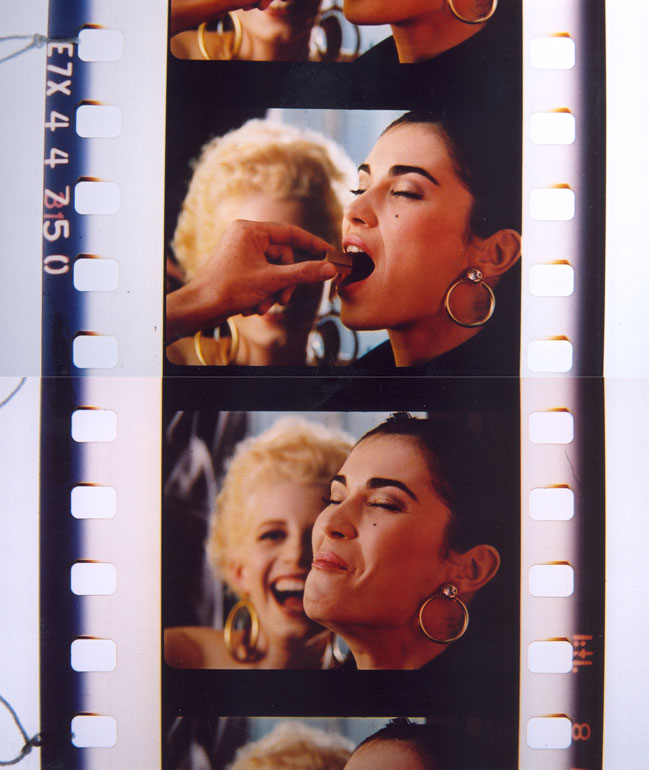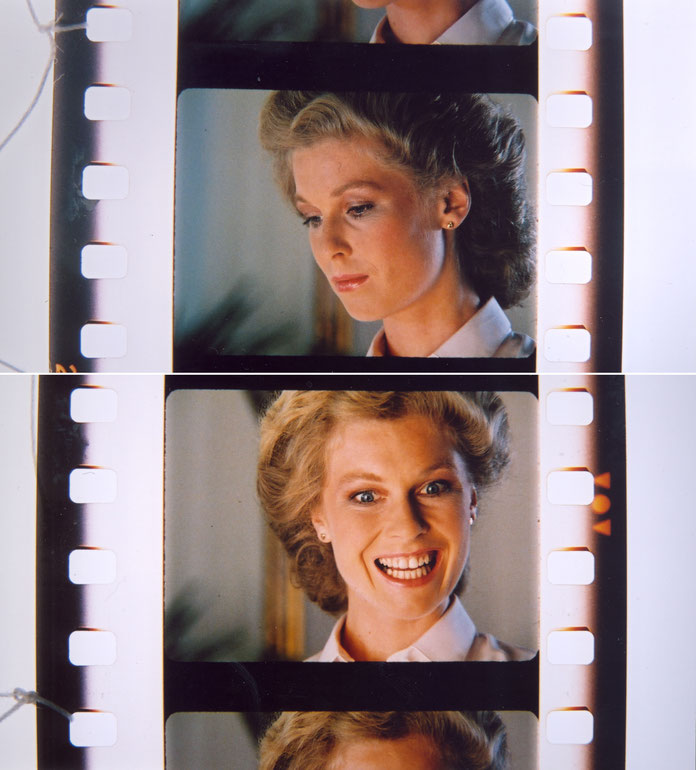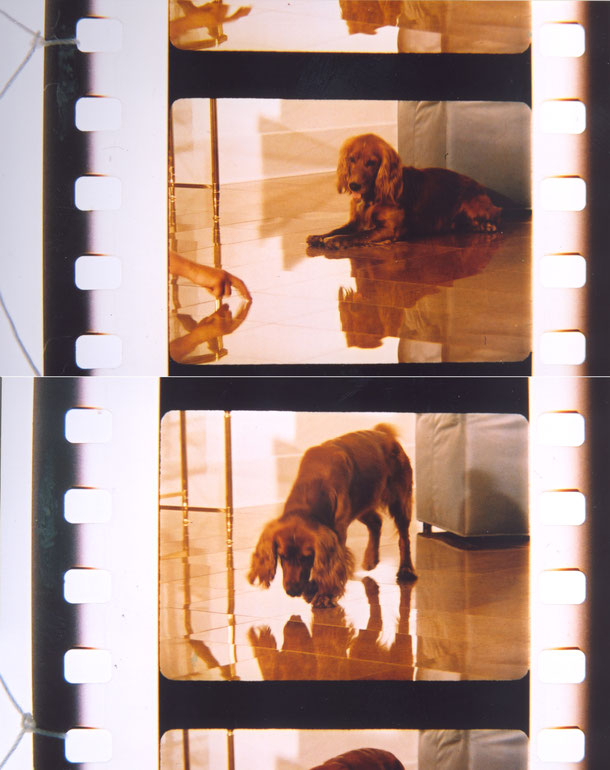Dichtung und Wahrheit
Es hätte Mut gebraucht, sagt Peter Kubelka, Dichtung und Wahrheit zu veröffentlichen. Viele, die sein bisheriges filmisches Oeuvre schätzen, könnten sich enttäuscht zeigen. Er selbst aber hätte seine Position radikal verändert, wäre aus der Rolle des virtuosen Künstlers in jene eines Jägers und Sammlers geschlüpft. In diesem Sinn seien die Aufnahmen zu drei Werbefilmen, aus denen Dichtung und Wahrheit besteht, nicht gefundenes, sondern gezielt gesammeltes Material: "Gathered Film".
Am Ursprung aller Kunst steht das Ready-made. Heute noch trägt bei den Inuit ein Bildhauer, findet er einen interessant geformten Stein, diesen bei sich, bis er in ihm eine Gestalt entdeckt. Mit sparsamen Eingriffen macht er diese dann auch für andere sichtbar. So ein behutsam korrigiertes Ready-made wollte Kubelka formen – und zugleich Raum lassen für zukünftige archäologische Fragen, wie wir sie heute noch gar nicht stellen können. Die Antworten birgt der Film schon jetzt.
(Peter Tscherkassky)
This Side of Paradise: Peter Kubelka´s Poetry and Truth (EN)
Within this context Kubelka unexpectedly, and with little fanfare, presented his first film in 26 years, Poetry and Truth (Dichtung und Wahrheit). The premiere of this 13-minute film becomes less surprising when you consider the gai savoir impulse and curatorial pedagogy that have defined Kubelka´s work over the past three decades. Apart from being great fun, Poetry and Truth adds another layer to the portrait of the artist as archeologist – as a hunter-gatherer of artifacts that, 100 or 500 years hence, may reveal the answers to questions that cannot even be conceived of today.
In the history of film culture, Kubelka stands alongside Jonas Mekas as a major cinematheque founder and archivist who is also an acknowledged part of the filmmaking canon. With just a few shorts, created frame by frame between 1956 and 1960 (Adebar, Schwechater, and Arnulf Rainer), Kubelka staked out film´s modernist edge – and its abyss: a degree-zero of sheer celluloid rapture, flamboyantly expressive of the medium´s potential as a new form of thinking.
If you experience cinema as 24 bursts of sight and sound per second, the question of 24 frames of truth (or lies) becomes irrelevant – you no longer measure these events against everyday reality. Once you feel and understand that material presentation precedes cinematic representation whenever you´re watching a film, you start to desire differently. From then on, every fictional or documentary truth you encounter in movies will be accompanied by a kind of surplus truth-of-the-matter; an additional beauty this side of illusionary paradise. Shifting between the implications of the representation and the immediate present of the presentation (both a gift and an experience of “contemporeality”), you are less and less likely to lose yourself in the land of Oz. You´d much rather meet the Wizard head-on and become part of what film theorist Elisabeth Büttner calls “the struggle between fiction and reality, which is the signature of cinematic perception.”
In a way, Kubelka did for the discrete cinematic event what John Cage did for the musical one: he made it appear beautiful and erotic as such. That said, there are probably as many film lovers who would declare Kubelka´s work to be “non-film” as there are music lovers who have nothing but contempt for Cage´s “non-music.” But then one can only assume that these are the kind of lovers who stop short of physical consummation – the practice of romance, which involves tactile sensation, fluids, and molecules pressing against one another in rhythmic movement. There may be more to art than sex, but great art is impossible without it.
Since the Seventies, Kubelka has been pursuing his lifelong goal of “de-specialization” – by practicing and teaching not just film but also cooking, archeology, music, and cultural history. By leaving filmmaking behind, he would avoid becoming trapped within the routines of virtuosity, and at the same time transcend the “wunderkind” label that so often becomes an albatross around the necks of modern art innovators. Instead, Kubelka would become a teacher-performer of the greatest story ever told: how humans think with their eyes and hands and ears and feet.
Poetry and Truth was originally presented, albeit in a different format, during one of the “What Is Film” lectures, in this case on the subject of “acting and being.” In addition to screening a “behind-the-scenes” reel filmed on the set of The Misfits, Kubelka showed 13 minutes of footage shot by unidentified cameramen for a number of TV commercials made by an Austrian production company. Given that his one-minute masterpiece, Schwechater (58), began life as a commission for a beer commercial, it would appear that his imagination had once again been aroused by the phantom world of advertising. While assembling the footage for demonstration purposes, the filmmaker succumbed to the impulse to also make the images speak with their own strange and beautiful logic.
One of the 60 programs in Kubelka´s Vienna film cycle is entitled “Found and Worked On-Perfectly Found” (“Gefundenes bearbeitet-perfekt Gefundenes”). It includes four Bruce Conner films in which a barrage of found footage is appropriated, heavily edited, and completely transformed, as well as Ken Jacobs´s Perfect Film (86), which presents unaltered newsreel material from 1965 that he found on a used reel purchased in a camera shop 21 years later. (The fact that both Conner´s Report and Perfect Film deal with the aftermath of political assassinations in the U.S. – those of JFK and Malcolm X, respectively – was not lost on Kubelka, I suspect.)
As an assemblage of unaltered camera originals, Poetry and Truth is much closer in method to the “pristine” Perfect Film than to Conner´s work. At the same time, it would be misleading to call it a “found” film. Its footage has been gathered, selected, and edited together at very specific junctures to produce an archival, pedagogical, and yet weirdly electrifying collection of ethnographic camera “views.” But instead of recording an unknown tribe´s way of life in the wilderness, this ethnography bears witness to certain of our own Western rituals – namely “make-believe,” “you-should-own,” and “go-and-buy.”
Following his “metrical” and “metaphorical” film phases, the latter exemplified by Our Trip to Africa (Unsere Afrikareise, 66), Kubelka now submits a new type of cinema for our consideration: the “metaphysical” film. Metaphysical in the sense that, for the first time in his career, Kubelka allows the medium´s materiality (i.e., what film physically consists of) to recede, and instead foregrounds cinema´s magical capacity to locate and record anthropological rules, rituals, and myths in the unlikeliest of places.
We see a man stopping before a mirror in a shop window, inspecting his face and arranging his hair (a big smile mid-shot: the preparation for love); then again, and again and again. We see a beautiful woman waiting to be fed a piece of chocolate (eyes closing, mouth opening wide, as the shot climaxes: we have lift-off); then again, and again and again. We see a face shrouded in darkness suddenly illuminated, a mother´s lips and teeth contorted into a smile, repeated over and over (until delight turns to horror). We see an empty blue plastic bucket on the floor, and it begins to glow from within, imparting to us the joy of being sought by the light, of being a star. We see a little girl pushing a doll in a baby carriage back and forth, again and again, as if she were the last woman on earth, insane but still clinging to what she remembers best-rocking her baby, dimly recalling herself in that carriage and neatly tucking in her doll.
Poetry and Truth features 12 such “stories”; 12 sequences, each composed of one shot that is repeated in three, or five, or a dozen variations. Each take captures a movement from a stasis to motion and back again. For Kubelka, the repetition of physical movement – as in dance, as in film, as in life – is the fundamental law of the universe, from which even civilization´s most complex systems derive. The act of conveying this principle via the “truth” (the camera originals) of commercials is certainly a form of “poetry” – but that´s not the source of the film´s title. At some point in each of these takes, the divine light of illusion falls upon people, dogs, buckets, and pasta. These simple “truths” are abruptly transformed into actors of “poetry,” and then, just as suddenly, fall back into their original nonpoetic selves. By extension, this precise and endlessly repeated alternation would be the “basic behavioral cell” that can be used to understand all forms of social existence. As archeologist and archivist, Kubelka is dutifully passing these telling artifacts on to the researchers of future generations.
It´s easy to see why Kubelka doesn´t want Poetry and Truth to be thought of as a critique of advertising. He´s after something more essential and isn´t interested in using his work to express “trivial opinions” about some aspect of modern life. He´d rather champion the joy of rhythm, the joy of life, and affirm the cyclical nature of human endeavor – even if it means affirming and preserving the remnants of a trivial economy in the process.
Nevertheless, I would argue that Poetry and Truth does support a more historical-materialist or “political” stance in two distinct ways. First, in formal and experiential terms, the historical-materialist is implicit in every shot. By retaining even the very last and most “useless” frames from the original takes – flashes of white light when the camera is shut off – the film documents and highlights the fact that cyclic movement is never continuous but consists of violent ruptures and jolts from which we construct a sense of progress.
Second, the film has a clear narrative dimension. For a start, we´re not just seeing actors before, during, and after “the moment.” We´re also looking at the strings of an anonymous puppetmaster. The hands and instruments of advertising mise-en-scène reach into the frame, directing the dog, feeding the woman, or making the pasta all fresh and seductive. In other words, the actors aren´t simply behaving of their own accord; they are also “acted upon” by external forces that serve a specific agenda. The actors are lit, directed, and twisted into shape; twisted into forms that can be traced back to the origins of life (in Kubelka´s terms); or twisted into the shape of things to come (in a different, more critical reading of advertising´s standardizing and normative power). Even if these scenes are interpreted as conveying deep-seated myths, repeating in nuce the essence of all storytelling, Poetry and Truth´s specific dramatic trajectory is unmistakable and hardly coincidental. Beginning with the smiling hero preparing for conquest and the woman seduced by chocolate, continuing with motherhood, food, and family life, and ending with a scene of autistic isolation, Kubelka´s “narrative” conveys a distinct feeling of doom. In the end, the unbearable sadness of this puppet theater and the payoff of the little girl and her cradle (the 12th circle of hell) are inseparable from the social and cultural context of the original footage. So, alongside the “essential” aspects of the film, there´s a specific and horrific violence here which matches the beautiful material violence that Kubelka inflicted on film-as-film nearly half a century ago.
I imagine Kubelka reflecting upon his lecture, sitting in his editing room with miles of advertising footage. The fun he must have had. The monstrosities he must have encountered. The essential idea he sought to demonstrate, right there in the footage. But the footage also reveals its own intrinsic thoughts – not Kubelka´s but those of the psychosocial economy that surrounds and inhabits filmmaker and audience alike. Some would call it the visual and gestural expression of ideology. Yes, the footage and the film will remain for future archeologists, yielding the answers to questions presently unimaginable. But we aren´t merely victims of nature, and we should not belittle ourselves: the footage and Kubelka´s film already yield answers to some of the questions confronting us today – as well as a different poetry and truth.
Alexander Horwath, September/Oktober 2004,
Link: http://www.filmcomment.com/article/this-side-of-paradise-peter-kubelkas-poetry-and-truth/
Dichtung und Wahrheit
1996 - 2003
Österreich
13 min



